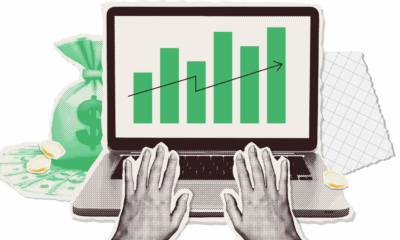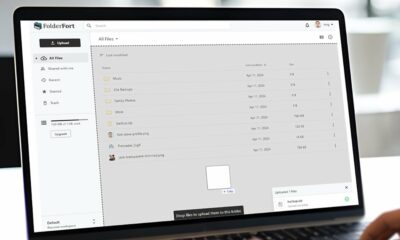MARKETING
What is a Media Mix & The Most Effective Types [HubSpot Blog Data]
![What is a Media Mix & The Most Effective Types [HubSpot Blog Data] What is a Media Mix & The Most Effective Types [HubSpot Blog Data]](https://articles.entireweb.com/wp-content/uploads/2022/03/What-is-a-Media-Mix-The-Most-Effective-Types.jpgkeepProtocol.jpeg)
I’m willing to bet that today, the typical campaign at any brand uses a media mix.
This refers to the process of using multiple channels to meet marketing goals. The question is, how exactly does it help brands better plan campaigns?
Let’s dive into how it works, review some stats, and see some brand examples.
Media Mix?
A media mix is a marketing term for the combination of channels a business uses to meet its marketing goals. It can include billboards, email, websites, and social media. Businesses might refer to their marketing mix when thinking about how to hit future campaign goals.
A media mix is another term for an overview of the channels businesses choose to execute their marketing strategies on. Ultimately, media mix optimization is the process of analyzing the performance of those channels.
Think about the last campaign you saw from one of your favorite brands. What did they do differently that really clicked with you? By incorporating a media mix into your yearly planning, you can narrow down what resonates with your audience.
Media Mix Example
To see how a media mix works for a campaign, let’s use makeup brand The Lip Bar’s latest campaign: “Something BAWSE is coming.”
To build anticipation around its latest product launch and celebrate its 10-year company anniversary, The Lip Bar launched a multi-channel campaign that reached audiences both online and offline.
First up, website.
![What is a Media Mix & The Most Effective Types [HubSpot Blog Data] media mix example showing makeup brand's campaign on their website](https://articles.entireweb.com/wp-content/uploads/2022/03/What-is-a-Media-Mix-The-Most-Effective-Types.jpeg)
When you land on the brand’s homepage, you’ll see an image of the CEO with the following sentence “Shark Tank said no, 12,000 5-star reviews later, 100% that bawse.”
Upon clicking on the image, you’ll arrive at a landing page that has a timeline of the brand. From launching in 2012, to opening its flagship store in 2019, then expanding to 1500+ stores in 2021. Once you get to 2022, you see the tagline “Something Bawse is Coming.”
As you continue scrolling, you reach a section that offers a launch date and time for the brand’s newest product.
The second digital channel the brand leveraged for this campaign is YouTube, publishing a 45-second video showing the CEO’s journey over the last 10 years.
Moving offline, the brand also published billboards in five cities to continue the campaign.
Note how the billboard didn’t use the tagline we saw on social media platforms.
![What is a Media Mix & The Most Effective Types [HubSpot Blog Data] media mix example showing makeup brand's billboard campaign](https://articles.entireweb.com/wp-content/uploads/2022/03/1646268351_926_What-is-a-Media-Mix-The-Most-Effective-Types.jpeg)
The benefit of using a media mix is to leverage different strategies to see which tactics work and lead to better conversions.
The Lip Bar’s latest campaign is a great example of how any brand can leverage channels differently to reach the same marketing goal.
Media Mix Stats in 2022
In January 2022, we surveyed over 600 media planners to discover their strategies, goals, and challenges. Here are some interesting findings:
- 84% of media planners surveyed leverage a mix of organic and paid media.
- Email marketing is the most leveraged media channel, used by 1 in 2 media planners.
- 41% of media planners surveyed will change their media mix in 2022, while 45% will keep it the same.
- 14% of media planners currently leverage non-fungible tokens (NFTs) while 16% plan to use them for the first time in 2022.
- 39% of those who use NFTs in their media planning say they have the best ROI of any channel in their media mix.
- 39% of marketers surveyed say determining the most effective media mix is the biggest challenge of media planning.
Media Mix Optimization
Media mix optimization provides businesses with an understanding of how their messages are coming across to customers. It allows a brand to invest more time and money into marketing strategies that are best suited for their audiences.
Marketers might consider optimizing their media mix if they want to gain some helpful insight into what time and capital is needed to target their audience in a way that gives customers a personalized experience.
But, while media mix optimization is a powerful opportunity for methodizing data collection online, it’s not the best strategy for marketers who employ a lot of traditional marketing techniques, since you can’t really measure the success of a billboard or newspaper ad.
However, to make guided decisions such as what font to use in creative design, when to publish social media posts on various channels, or where to invest resources, this method can be helpful.
Optimizing a media mix means looking at the analytics and ROI of various marketing strategies. This can be anything from engagement data of social media platforms to views on the newest commercial.
That’s where media mix modeling comes in. If media mix optimization is the “what,” modeling is the “how.” Every model can (and should) look different, depending on your marketing and broader business goal.
Media Mix Modeling
Media mix modeling, also known as marketing mix modeling, is an analysis technique used to measure campaign impact and determine how each channel (and certain elements) contribute to conversions. Results from media mix modeling allow marketers to learn what drives conversions to create campaigns that offer a high return on investments.
Media mix models can be used to analyze the relationship between a dependent variable and an independent variable.
For instance, let’s say a business has a question like, “How did paying for a sponsored tweet affect overall blog traffic?” The business’s media mix model should then accurately depict how a dependent variable – like overall blog traffic – relates to an independent variable, such as investing in Twitter.
For businesses still deciding if a media mix optimization is a good idea for them, we’ve put together key tips to guide you when creating a media mix model. Let’s explore those, next.
Tips for Optimizing Your Media Mix
1. Collect personal level data.
The goal here is to find and focus on analytics that will help provide an accurate picture of how customers engage with your media mix.
Analytics software is expansive and offers an array of tools for use. If you’re in the market for one, the HubSpot Marketing Hub is a great place to go.
Having too many metrics can be confusing and lead to inaccurate data. The best plan is to have an idea of which metrics need to be tracked so they can be right at the beginning.
A normal media mix optimization process can take anywhere from a few months to a year. So, collecting the right information at the beginning contributes to getting the most accurate information overall.
2. Have a robust reporting process.
When using a media mix, you often combine online and offline strategies. With this in mind, it can be more difficult to measure the impact of a billboard compared to a paid social ad.
That means you’ll have to think outside of the box when evaluating your media mix. For instance, while an online ad will have clear conversion rates you can find, a billboard may require some creative tracking.
Perhaps, you can track the uptick in branded search volume or improved brand recall.
This requires having a robust reporting process that accounts for the events you’ll be tracking – both online and offline.
3. Choose the right platform.
Marketing teams that use CMS or analytics software are already ahead of the game. Software like this is essential to optimizing a media mix because it can give you numbers that would otherwise take some time to figure out manually.
A brand can analyze its media mix with the use of platforms that collect engagement data in real-time and compile that data into tracking reports.
Look for a platform that can give a holistic view of results across the board, so results will maintain consistency. It’s also good to choose software that specializes in the marketing channels being used at the time.
Because optimizing is measuring a lot of different data at once, stick to as few systems as possible.
For businesses that are in the market for a CMS, HubSpot offers tools that are easy to use for brands of any size.
4. Analyze the data.
We’ve been talking a lot about the kind of data and analyzing that needs to be done in a media mix optimization, but another important factor is being able to interpret and understand that data.
It’s no secret that in the marketing world, there is an abundance of processes and acronyms floating around. While first getting into the groove of understanding them and what they mean can be intimidating, it’s important to know the data being collected and how to use it to your advantage.
For instance, if a marketing team had especially high click-to-open rates for weekly newsletters, that’s useful information to infer that the next campaign could benefit greatly from an email-marketing rollout. Alternatively, if a marketing team has no idea what a click-to-open rate is, those numbers aren’t going to be helpful — just a little confusing.
Reading data to understand its usefulness is just as important as collecting it.
5. Consider public perception.
Knowing how the public perceives your brand can help fill in some interpretation gaps during the modeling process. In the media mix model, think about how to fit in customer opinion. That way, the numbers will have some customer opinions to define them.
There are a couple of ways to do this.
To better understand your brand perception, monitor your brand mentions on social media. Take note of the positives, the negatives, and the questions. You can also create a survey to know how your customers feel about your company and its services and use a net promoter score.
An NPS asks customers how likely they are to recommend a business to a friend. Knowing this will aid in figuring out how a business fares among the competition in the market. It will also assist in future marketing endeavors.
For instance, if customers fill out your survey and ask for more personalized Instagram stories, your team could take that knowledge and include it in your next campaign.
This method ultimately gives the media mix optimization reigns to the customer.
Media mix optimization can help your marketing team figure out which distribution channels will best promote an upcoming campaign, and can ultimately help strengthen your marketing strategy as a whole.
Editor’s Note: This post was originally published in Feb. 2020 and has been updated for comprehensiveness.

![What is a Media Mix & The Most Effective Types [HubSpot Blog Data] Blog - Content Mapping Template](https://articles.entireweb.com/wp-content/uploads/2022/02/1645053109_359_What-Is-Content-Operations-A-Straight-Forward-Guide.png)

















You must be logged in to post a comment Login